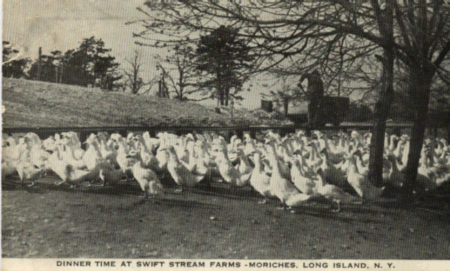 |
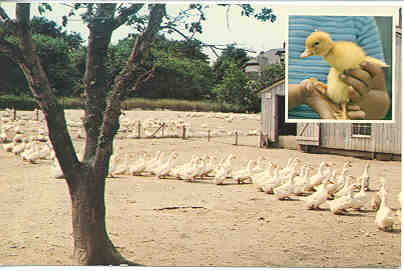 C&R Duck Farm Westhampton Long Island NY |
| Home Return to Long Island Genealogy |
Email |
| 1. Long Island
Records |
2. Surname Databases |
3. Long Island Reference Books on
CD |
4. SITE SEARCH |
 |
 C&R Duck Farm Westhampton Long Island NY |
|
Of the
transition to the Island, little is known. According to one historian,
the Speonk and Eastport area was the starting point in 1885, and it had
at one time the largest duck Farm in the world; A.J. Hallock's Atlantic
Farm on Speonk River. This farm set a record of a quarter of a million
ducks raised in a year. The hurricane of 1938 wiped it out. The Peking duck lacks one instinct, it has little maternal feelings, but it is a good breeder. Usually a good duck lays 150 eggs in its laying span each year, and an important part of duck raising is determining which ducks to keep for breeders. Naturally one continually wants to improve the stock, so those which have a well placed eye, good shaped head and neck and a wide deep breast are kept for breeders. Previous to the introduction of the first incubators in 1890, "broody" hens had been in great demand at a dollar a head to hatch out these ducklings. |
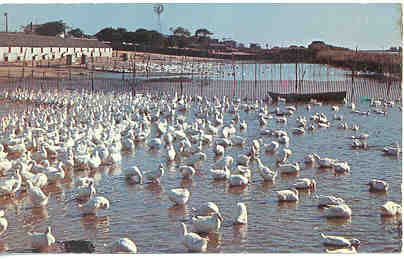 |
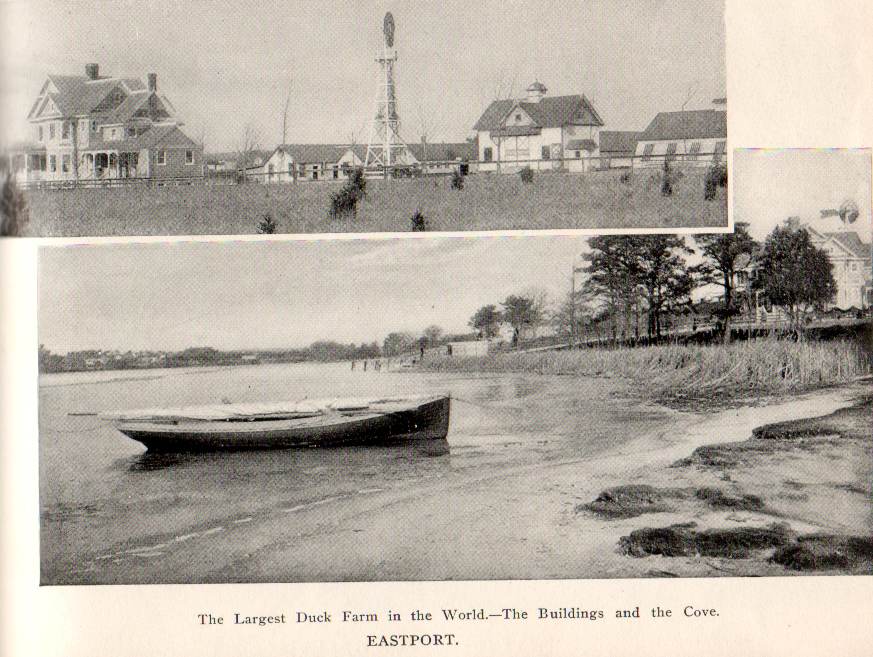 The Largest Duck Farm in The World - abt 1910 Raised 23,000 Ducks a year at it's height |
Some
duck farms
today only raise baby ducks. These ducklings are then sold to
surrounding
duck farms. This necessitates the keeping of many breeders throughout
the
year. Those in the know, if possible, used to buy breeder ducks for
their
own eating pleasure. These are not force fed and do not grow at such a
rapid pace, so the meat is firmer and not so fat. Many farmers got a few eggs and raised their own and fed them right along with the chickens. I remember when my grandfather had a duck farm, he gave my brother eight baby ducks. They all grew up and they got to be pets. How my mother used to scold when they followed all the members of the family into her clean kitchen. One instinct of Peking duck works to the growers advantage. It is a glutton; it will eat as much as is put before it. The first duck farms used fish as a primary food. Great kettles of them were cooked up and then mixed with cornmeal and bran. The young ducks went for this, devouring everything but the bones. Finally, the practice of feeding fish reached a point where the Commission merchants complained, the customers were rebelling. If they wanted fish, they would buy fish, but they didn't want "fishy" duck. After this all shipments of ducks carried a tag, “This duck guaranteed free from fish." |
| The
firt duck
farm in the Riverhead area was started by Asa Fordham in an old
ramshackle
building on what was to become known as the A. B - Soyars Duck Farm,
located
on Peconic River. In 1902. Mr. Soyars bought out Mr. Fordham and in
1903
had the farm in operation. In time it grew to be one of the larger duck
farms. Mr. Soyars had gained his experience at the A.J. Hallock Ranch
in
Speonk where he worked for a time. He then went to Pennsylvania to
manage
a duck ranch there, but he soon came back to Long Island as he wished
to
have his own duck ranch. Dennis G. Homan, a few years later, started
his
duck ranch farther down on the Peconic River and it is said that Henry
Corwin of Aquebogue started his ranch with 30 "breeders" in 1910.
Ducks in those early years sold for around 14cents a pound and were considered in the luxury price range. Park & Tilford, the well known confectioners, at that time were in the food processing business. They bought the "cull" ducks for 7 cents a pound and canned ed them in a mushroom sauce and sold a small container for 65 cents. A food for a gourmet, no doubt. |
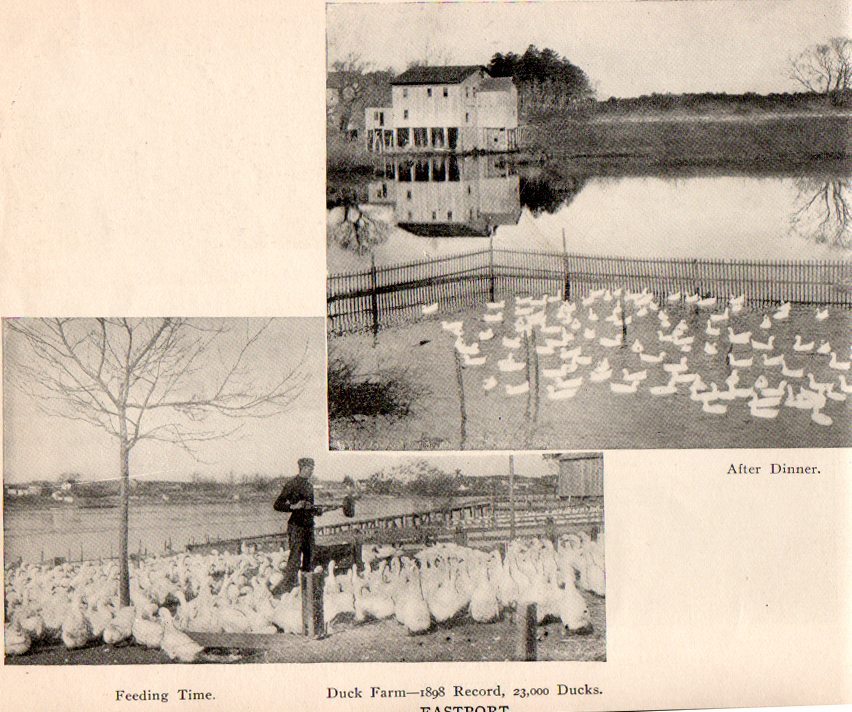
|
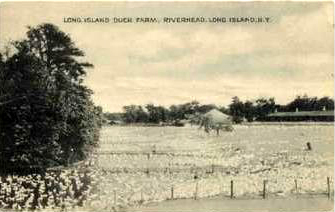 |
That problem solved, the duck growers were faced with another, the excrement and fermenting food, from millions of ducks. All who have watched young ducks have seen them force down as much food as possible, run to the water, drink and lose some food, then rush back to the feeding station, again and again. All the streams became badly polluted, then flowed into the bays and they in turn became polluted, ruining them for bathing and fishing. The demand for clean water became so strong, the State set up certain restrictions that had to be met. Many small ranches had to fold up. The restrictions must be doing the trick, as the various waters are becoming cleaner. |
The story of duck growing
in Suffolk County dates back to about 1890, when a boy fisherman at
Eastport
set a nest full of peking duck eggs under a brooding hen. The hatch was
successful and the experiment duplicated, though the parent hen held
her
downy golden duckling crop in dubious esteem. Raised on a diet of field
greens and cooked fish, and allowed to run in a pen placed beside a
private
stream, the ducklings developed rapidly and within three months were
shipped
alive to a virgin market. The idea of this new industry had logic and
was
taken up on a small scale by other south shore farmers and baymen
having
a pond or stream on their premises. These men for some time
continued
in their former pursuits, entrusting to the care of their helping wives
the raising of ducklings to augment the family income.
Diligently, and
with a canny foresight which has marked the forward progress of all
Suffolk
County's important industries, the habits and diet of the duckling was
studied and improved upon A tender meat of full rare flavor was
eventually
produced, precipitating a craze for Long Island ducklings which just
prior
to the out break of the World War swept across the country. To meet the
resultant sharp increase in demand for this distinctive delicacy
literally
multitudes of new duck farms sprang into being, principally in the
Moriches,
Eastport and Riverhead districts.
Approximately
six million ducklings are now produced annually on the ninety odd
farms,
or ranches, located throughout the County. From this source also
comes yearly four to five hundred tons of feathers, a valuable by
product.
At least two banks in the more concentrated producing areas are
functioning
mainly on the turnover of revenues from Suffolk's duck industry, and
the
prosperity of certain communities is perpetuated by reason of the
employment
it offers both men and women.
Not less than
4,000 carloads of scientifically mixed foods consisting of grains, cod
liver oil, meat and milk ingredients are consumed each year by Suffolk
County's ducklings. These are balanced with a variety of green field
crops
to obtain an ideal ration. Huge modern all-electric incubation systems
common on the larger ranches has stepped up the production on some of
these
operations to an output of 250,000 ducklings annually. During the
growing
period, scientifically gauged to from ten to twelve weeks, each
duckling
will consume an amount of food approximating five times its market
weight
of from five to seven pounds. Complete sanitation, utterly essential to
the life of the duckling, is stressed throughout every phase of duck
raising
in Suffolk County. Strong floodlights are burned at night to make the
duckling's
life one of perennial daylight, thus preventing panic which the
slightest
noise in the dark will create among the flocks.
What transpires
within a modern incubator on the twenty-eighth day after the duckling
eggs
have been placed for hatching is one of nature's phenomena. A slight
rocking
of an egg here and there among the hundreds stacked uniformly on racks
foretells the first stir in the duckling's life. Within a few moments
the
porous shell will have broken before the pressure of a feeble body,
after
which the new-born duckling will extricate itself and rest,
quizzically,
gaining an amazing vitality while almost with perfect timing the other
eggs will break, transforming the trays within a few hours into a maze
of pale gold life. The ducklings are next placed in heated brooder
houses,
kept there from two to six weeks depending on the season, and finally
moved
into pens on the stream, where they are developed for market.
Hygienically
killed, picked and chilled at the ranch, the ducklings are then trucked
to the markets in adequately iced barrels, or put through a recently
developed
quick freezing process whereby all their delicate and superlative
flavor
is retained. For quick-freezing the chilled duckling carcasses are sped
from the nearby ranches to a modern eviscerating plant at Eastport.
Where,
under the watchful eyes of a U. S. government inspector they are
dressed,
quick- frozen, and individually wrapped in cellophane for shipment; or,
by another method of quick- freeze packing accomplished in a costly
plant
maintained at Riverhead, the duckling carcasses are subjected to a
brine
spray under a sub-zero temperature until they have obtained a
completely
frozen state, when they are rinsed in clear ice water and packed in
attractive
cartons containing twelve each. Then, less than six hours after being
slaughtered
at the ranch, they are ready to be loaded into refrigerated trucks and
sent on to supply an ever-receptive world market!
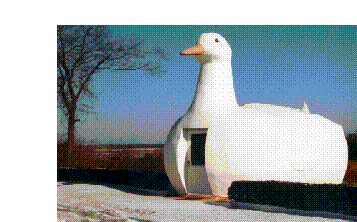
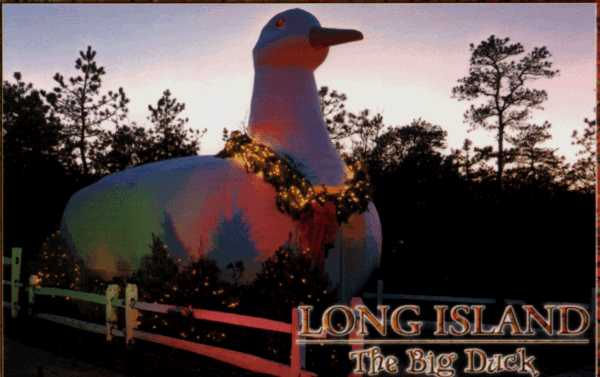
Located in the Sears-Bellows Pond County
Park, just off the Riverhead-Hampton Bays Road.
The Duck was built in 1930-1931 and was
originally used as a retail outlet selling Long Island
Duckling. Every December the Big
Duck is decorated for the holiday season.
The following
article
appeared in Newsday on May 26, 1995
Written By Rick Brand STAFF WRITER
(Newsday)
Copyright © Newsday, Inc.
Fresh from a
tail
tuck and internal surgery, Long Island's Big Duck reopens tomorrow to
do
what it always has done best - sell itself. Move over Disney Store,
watch
out Opryland. Make way for designer duck.
Admittedly, the
first step, er waddle, is small. But it may foreshadow a big step for
Long
Island - a theme park dedicated to roadside art. For now,
the
Big Duck - built in the 1930s by a Depression-struck farmer to sell
fresh
duck and duck eggs to motorists - will reach out to the passing public
with a gift shop and a small museum. It will sell a full line of Big
Duck
clothes and souvenirs - from golf shirts to umbrellas complete with
duck
beaks. It will also include a mini-exhibit of duck, highway and
roadside
architecture history.
Loudspeakers
will beguile passersby with a two-hour long mix of music and news
commentary
from 1931 to 1939 along with Christie Brinkley's narration of Big Duck
history. The idea is not only to take on the marketing gimmicks of
retailing
outlets like the Disney Store but also to re-create the atmosphere of
picnic
parks, places where Long Island families used to take family drives.
And to do it
in the spirit of roadside art, once scorned by architectural purists as
trash, but more recently praised for its celebration of fantasy.
"I think people
are taken by the whimsy of it," said Jerry Kessler, president of the
Friends
for Long Island Heritage. He also said in some cases the appeal is more
direct. "When I was a kid, I remember sitting in the back of my
grandmother's
1929 Nash and going for a Sunday drive," said Kessler, now in his
sixties.
"Seeing the Big Duck was a great thrill for a seven or eight-year-old."
Long-range, the
county and Friends for Long Island's Heritage envision a park of
roadside
art and other motoring artifacts including neon signs, old-fashioned
gas
pumps and perhaps even a diner. But officials say that given the county
government's ongoing financing problems, such grand plans are five to
10
years away and $200,000 to $300,000 beyond their current means.
For the moment,
even getting the duck spruced up for the '90s was a larger than
expected
chore. Although the duck only had to move 40 feet from its temporary
quarters
at Sears Bellows Park on Route 24 in Flanders, parks officials say the
cost of primping the 20-foot-high water fowl for its reopening went
three
times beyond its $10,000 budget - causing an unexpected drain on the
Friends,
who are the duck's main support.
"It's coming
out beautifully," said Lance Mallamo, Suffolk's director of historic
services.
"But as we started working, we found out there was more work than we
bargained
for."
Because the duck
is listed on the National Register of Historic Places, it had to be
reconstructed
in a way that was faithful to its original design. Restorers for
example
had to put down a tongue-and-grove pine flooring, and replicate tin
walls
of the original duck.
In the process,
they also expanded the duck's wood framing to bolster its sagging
haunches,
increase structural strength and cut down on cracks. And they also had
to re-stucco the bird's exterior.
To celebrate
tomorrow's reopening, parks officials are baking their own sculpted
duck
cake, children from Phillips Avenue School in Riverhead will sing
several
new duck songs and relatives of the forward-thinking pioneers who
helped
build the world-famed duck will be in attendance.
They will all
celebrate the idea first hatched in 1931 by Riverhead duck farmer
Martin
Maurer, who got his inspiration when he stopped at a roadside coffee
shop
shaped like a pot while on vacation in California.
Maurer hired
local carpenter George Reeve, who employed two stage show set
designers,
William and Sam Collins, to build the duck. As models, they used a a
cooked
chicken carcass and a live duck tied with a string to a perch. The done
duck was lit with the taillights of a Model T Ford placed in its eyes.
At its first
opening, the Big Duck was pictured in Popular Mechanics magazine. The
Atlas
Cement Co., whose product was used in construction, made the duck a
pinup
in its annual calendar and dubbed it "The Most Spectacular Piece of
Cement
Work in 1931."
The first site
of the 16,500-pound duck was on West Main Street in Riverhead, but in
1936,
it was moved about four miles east to Flanders Road, about two miles up
from its current location. Through the years, the duck remained in use
as a stand for duck farm produce. In 1987, owners Kia Eshghi and his
wife
Pouran sold the land on which it stood and donated the duck to Suffolk
County. It was moved to Sears Bellows in December, 1987.
Since then, the
duck's only activity has been as a model. It has been the subject of
cover
art for a 1987 edition of New Yorker magazine and a sketch now on
display
at Guild Hall, both by renowned East End artist Saul Steinberg.
Officials say
the newly-reopened duck and its shop will operate seven days a week, 9
a.m.-5 p.m. from Memorial Day to Labor Day and perhaps on weekends into
the fall.
County historical
officials are also hoping that the duck's reopening will spur a new
outpouring
of duck lore and memorabilia. Richard Martin, Suffolk's assistant
director
of historic services, said that one idea is to compile an oral history
of duck recollections. "For many visiting the Hamptons," said Martin,
"the
duck was a sign we're almost there."
Meanwhile,
Kessler
said he hopes the reopening will spur new contributions to fund-raising
efforts and ensure that tomorrow's small waddle for the duck is a big
step
for Long Island.